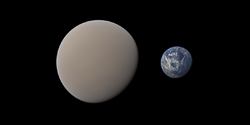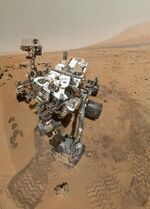Astronomy:HD 40307 g
 Approximate size comparison of HD 40307 g with Earth. | |
| Discovery | |
|---|---|
| Discovered by | Mikko Tuomi et al. |
| Discovery site | La Silla Observatory, Chile |
| Discovery date | October 28, 2012 |
| radial velocity, using HARPS | |
| Orbital characteristics | |
| 0.600 AU (89,800,000 km) | |
| Eccentricity | 0.22[1] |
| Orbital period | 197.8 ± 9.0[1] d |
| Semi-amplitude | 0.95 ± 0.3[1] |
| Star | HD 40307 |
| Physical characteristics | |
| Mean radius | 2.39[2] R⊕ |
| Mass | 7.09[2] M⊕ |
| Physics | 277.6[3] |
HD 40307 g is an exoplanet candidate suspected to be orbiting in the habitable zone of HD 40307. It is located 42 light-years away in the direction of the southern constellation Pictor. The planet was discovered by the radial velocity method, using the European Southern Observatory's HARPS apparatus[1][4][5] by a team of astronomers led by Mikko Tuomi at the University of Hertfordshire and Guillem Anglada-Escude of the University of Göttingen, Germany .[6]
The existence of the planet was disputed in 2015, as more Doppler spectroscopy data has become available.[7]
Planetary characteristics
The codiscoverer Hugh Jones, of the University of Hertfordshire in England , surmised: "The longer orbit of the new planet means that its climate and atmosphere may be just right to support life."[4]
However, another astronomer, Rory Barnes of the University of Washington, had already studied the orbits of the planets b, c, and d. First, Barnes had presumed b to take on too much tidal heating for it to be terrestrial, instead predicting a "mini-Neptune". He thought that b, c, and d had all migrated inward,[8] which extrapolates to e and f as well, which are further out, but not by much. It is possible that HD 40307 g has also migrated into where it is now. The discoverers of HD 40307 g did not try to refute Barnes, on the nature of b and its extrapolation to the other planets. The composition of g is unsettled.[9] Lead author Mikko Tuomi, also of the University of Hertfordshire, stated "If I had to guess, I would say 50-50 ... But the truth at the moment is that we simply do not know whether the planet is a large Earth or a small, warm Neptune without a solid surface."[4]
See also
- Circumstellar habitable zone
- Extrasolar planet
- List of potentially habitable exoplanets
- Planetary habitability
References
- ↑ 1.0 1.1 1.2 1.3 Tuomi, Mikko; Anglada-Escudé, Guillem; Gerlach, Enrico; Jones, Hugh R. A.; Reiners, Ansgar; Rivera, Eugenio J.; Vogt, Steven S.; Butler, R. Paul (17 December 2012). "Habitable-zone super-Earth candidate in a six-planet system around the K2.5V star HD 40307". Astronomy & Astrophysics 549: A48. doi:10.1051/0004-6361/201220268. Bibcode: 2013A&A...549A..48T.
- ↑ 2.0 2.1 "PHL's Exoplanets Catalog - Planetary Habitability Laboratory @ UPR Arecibo". http://phl.upr.edu/projects/habitable-exoplanets-catalog/data/database.
- ↑ "HEC: Data of Potential Habitable Worlds". University of Puerto Rico at Arecibo (Planetary Habitability Laboratory). November 12, 2012. http://phl.upr.edu/projects/habitable-exoplanets-catalog/data.
- ↑ 4.0 4.1 4.2 Wall, Mike (November 7, 2012). "'Super-Earth' Alien Planet May Be Habitable for Life". Space.com. http://www.space.com/18393-alien-planet-super-earth-habitable-hd-40307g.html.
- ↑ Tate, Karl (November 7, 2012). "Super-Earth Planet: Potentially Habitable Alien World Explained (Infographic)". Space.com. http://www.space.com/18390-super-earth-exoplanet-habitable-zone-infographic.html.
- ↑ Murrin, Marc (November 8, 2012). "Astronomers discover a potentially habitable Super-Earth HD 40307g (Infographic)". tech-stew.com. http://www.tech-stew.com/post/2012/11/08/Astronomers-discover-a-potentially-habitable-Super-Earth-HD40307g.aspx.
- ↑ Díaz, R. F. et al. (2016). "The HARPS search for southern extra-solar planets. XXXVIII. Bayesian re-analysis of three systems. New super-Earths, unconfirmed signals, and magnetic cycles". Astronomy and Astrophysics 585: A134. doi:10.1051/0004-6361/201526729. Bibcode: 2016A&A...585A.134D. https://www.aanda.org/articles/aa/full_html/2016/01/aa26729-15/aa26729-15.html.
- ↑ Barnes, R.; Jackson, B.; Raymond, S.; West, A.; Greenberg, R. (2009). "The HD 40307 Planetary System: Super-Earths or Mini-Neptunes?". The Astrophysical Journal 695 (2): 1006–1011. doi:10.1088/0004-637X/695/2/1006. Bibcode: 2009ApJ...695.1006B.
- ↑ University of Toronto astronomer Ray Jayawardhana, author of Strange New Worlds: The Search for Alien Planets and Life beyond Our Solar System. Paraphrased in Dan Vergano (November 7, 2012). "Habitable zone 'Super Earth' candidate planet detected". https://www.usatoday.com/story/tech/sciencefair/2012/11/07/habitable-super-earth/1690169/.
External links
- "Super-Earth Discovered in Star's Habitable Zone". 2017-05-10. http://news.discovery.com/space/habitable-zone-exoplanet-super-earth-121107.html.
Coordinates: ![]() 05h 54m 04.2409s, −60° 01′ 24.498″
05h 54m 04.2409s, −60° 01′ 24.498″
 |




